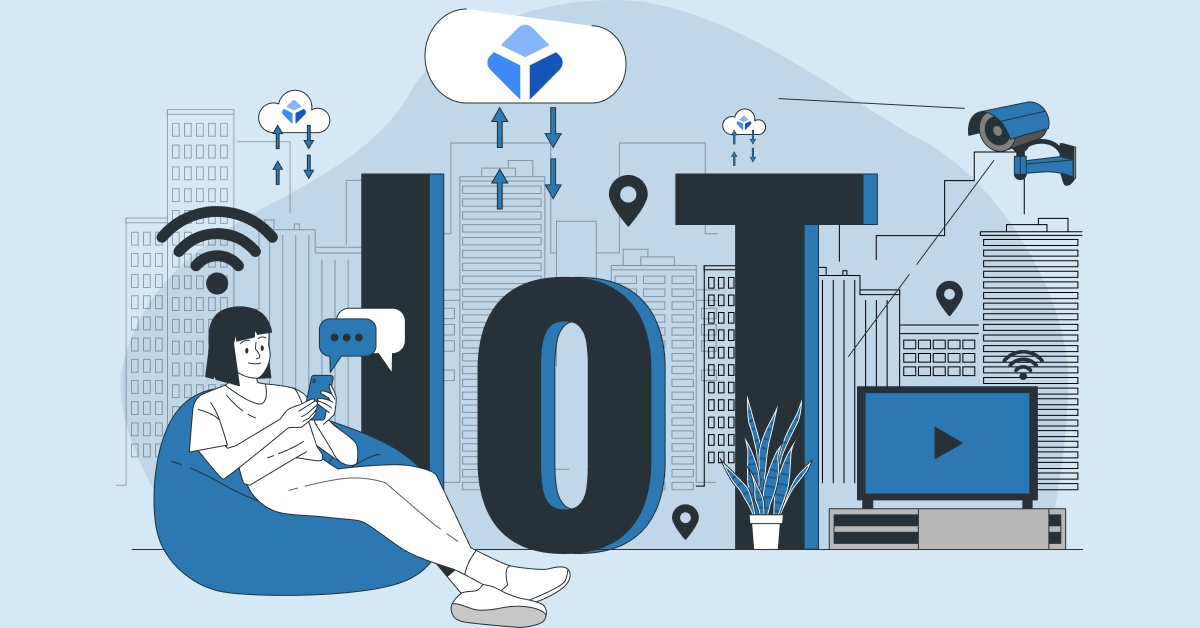
The Fusion of Technologies: Exploring Blockchain in IoT
-
By Paramjit Singh
-
27th March 2024
The world has wrapped its head around numerous revolutionary technologies. Speaking of which, the Internet of Things and Blockchain are two of the most significant technological advancements reaching their peaks.
While Blockchain is a distributed ledger technology popular for its high security and decentralization features, the Internet of Things (IoT) is prevalent for its ability to digitize physical devices. Imagine a crossover between the two technologies that harness the power of Blockchain’s data integrity and IoT’s data connectivity. This ultimate fusion of the two technologies is often referred to as the Blockchain of Things (BCoT).
In fact, both of these technologies are autonomous, distributed, and mostly decentralized systems that can complement each other very well.
This blog discusses these two technologies, the applications of Blockchain in IoT, and the benefits of consolidating Blockchain and IoT.
What is Blockchain Technology?
Blockchain technology first came into existence in 2008 with the introduction of Bitcoin cryptocurrency. The exchange of Bitcoin was enabled with this technology. Later on, the technology started to exist independently.
Blockchain can be defined as follows:
Blockchain is a distributed or shared ledger technology (DLT) that refers to a shared database that stores any type of data in chronological order of transactions. This data is stored along with the transaction timestamps in a tamper-proof manner.
The transactional data is organized in blocks that are linked through the protocol through hashing and consensus, thus making a chain of hashes. One cannot delete or modify any of these existing blocks.
Known for its high data security and integrity, Blockchain leverages cryptographic asymmetric key encryption mechanisms and mathematical hashing for data security. It is an autonomous, immutable, decentralized (no intermediary), encrypted technology with a Peer-to-Peer (P2P) node-based consensus approach.
What is IoT Technology?
The “Internet of Things”, also known as IoT, was first introduced by Kevin Ashton, one of the co-founders of MIT’s Auto-ID Lab, in 1999. It refers to a series of electronic devices that can share and transfer data to each other, typically through the Internet.
Numerous Internet of Things devices are available. Smart toys, wearables (like watches and glasses), appliances (including TVs, speakers, and lightbulbs), smart meters (like thermostats), commercial security systems, and smart city technologies (such as those that track traffic and meteorological conditions) are few examples.
IoT technology is blurring the lines between the digital and physical realms. The connectivity between the two increases operational efficiency, automates processes, and allows for data maintenance via predictions.
Understanding the Importance of IoT-Blockchain Intersection
As discussed before, Blockchain and IoT technologies complement each other. IoT requires strengthening of its security features. On the other hand, Blockchain needs contributions from distributed nodes for its Peer-to-Peer (P2P) consensus model. This is how these two technologies can help each other foster and become more refined.
There are many applications of Blockchain for IoT and vice versa. The convergence of the two technologies offers transformative potential in various domains, such as supply chain management and healthcare.
Enterprises and business organizations can take advantage of this synergy between Blockchain and IoT to harness the power of intelligent and connected ecosystems.
To understand the convergence of Blockchain in IoT, let’s take a perfect example of a transactional application of IoT with Blockchain. If you’re a businessman who runs an expensive, well-bred meat business, you can track the location and temperature of the meat as it is transported from point A to point B.
Thanks to the secure database, which is based on blockchain, you can track the location, as the records are immutable. The IoT sensors can also inform you about the temperature at which the meat was kept while being transported. This application explains how middlemen can be eliminated in this process because of the IoT-Blockchain intersection.
What are the Applications of Blockchain in IoT?
Blockchain and IoT are emerging technologies that have already disrupted the industry as independent entities. Since IoT functions by using the Wireless Sensor Network (WSN), the technology is prone to privacy and security threats. Blockchain is considered a trust machine because of its P2P consensus methods and cryptographic techniques.
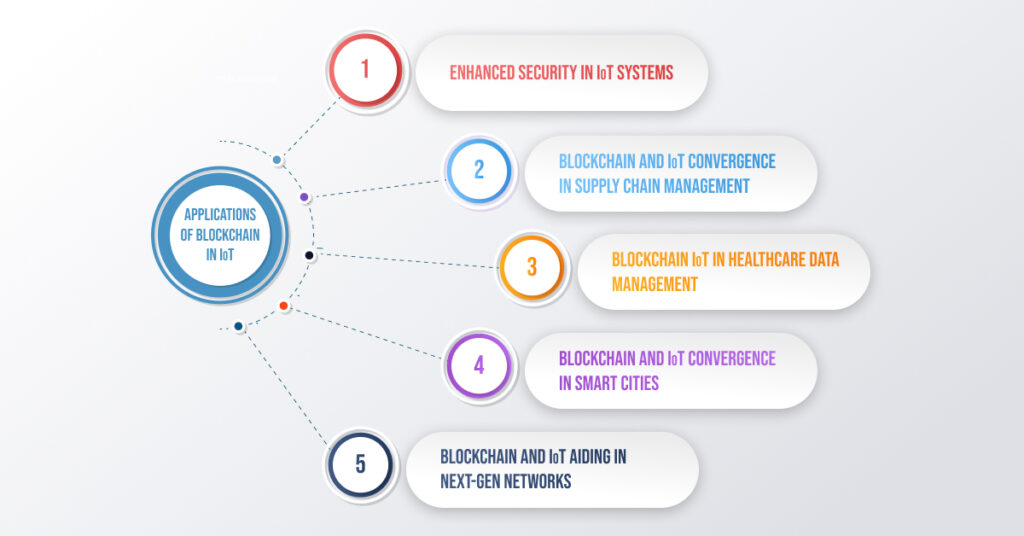
The highlighting applications of IoT with Blockchain are mentioned as follows:
- Enhanced Security in IoT Systems
IoT devices work in a network of wireless sensors. The nodes in these IoTs are susceptible to malicious attacks, such as Distributed Denial-of-Service (DDoS) and other malware, injection attacks, etc. Also, IoT networks are mostly leveraged in cloud environments. Since cloud networks are centralized architecture, they can suffer from a single point of failure (SPF).
IoT devices also collect and generate large volumes of data over the Internet for informed decision-making. Data privacy and security are huge threats to IoT environments, and all these factors combined make IoT systems unreliable.
With the integration of IoT with Blockchain, IoT devices can be secured with decentralization with an immutable record of data.
- Blockchain and IoT Convergence in Supply Chain Management
Goods can be tracked and managed more efficiently with the integration of the Internet of Things and Blockchain technology. IoT Blockchain devices that function on wireless sensors can monitor the location, movement, and condition of products in real-time.
The integration of blockchain technology allows the creation of an immutable and transparent record of transactional blocks. Therefore, the technology keeps stakeholders updated on the origin, authenticity, and location of goods and eliminates counterfeiting.
One great example of the application of Blockchain and Internet of Things (IoT) integration is how Walmat utilized a Blockchain IoT solution to track the journey of the products from suppliers to store shelves in collaboration with IBM.
- Blockchain IoT in Healthcare Data Management
IoT and Blockchain integration have valuable applications in the healthcare industry. For example, wearable sensors and implantable devices help gauge patients’ health metrics, vitals, health histories, etc. This functionality allows the generation of valuable real-time data.
It is a significant application as it allowed the introduction of IoT-based configurable blockchain. It also enables the creation of personalized healthcare systems with secure data storage and analysis. Data integrity is indeed very important in the healthcare sector, and IoT in Blockchain ensures it.
- Blockchain and IoT Convergence in Smart Cities
Urban landscapes can be converted into sustainable smart city ecosystems with the Blockchain IoT intersection. These smart cities will be interconnected through IoT devices equipped with Blockchain capabilities that provide high security, data integrity, transparency, and flexibility.
For instance, leveraging a Blockchain-defined network and a grey wolf-optimized modular neural network to enhance security in smart environments. The technology effectively eradicates confidentiality issues.
Another important application is the Blockchain-of-Blockchains (BoBs), which is a hierarchical blockchain-based platform created to address data management challenges. It ensures data integrity and interoperability in smart cities.
The city of Dubai is a real-life example of implementing Blockchain and IoT. The government is actively using blockchain in the city to empower various systems, such as security. It is ready to become the first blockchain-powered city.
- Blockchain and IoT Aiding in Next-Gen Networks
Blockchain technology can also be utilized to strengthen IoT networks and move forward to adopt the transition toward next-generation networks, such as 5G and beyond. Technology can play a pivotal role in allowing efficient service orchestration in 5G multi-cloud environments and enhancing resource management in 6G upcoming networks.
The next-generation network systems can be made more solid and secure with the integration of IoT Blockchain.
What are the Benefits of Blockchain in IoT?
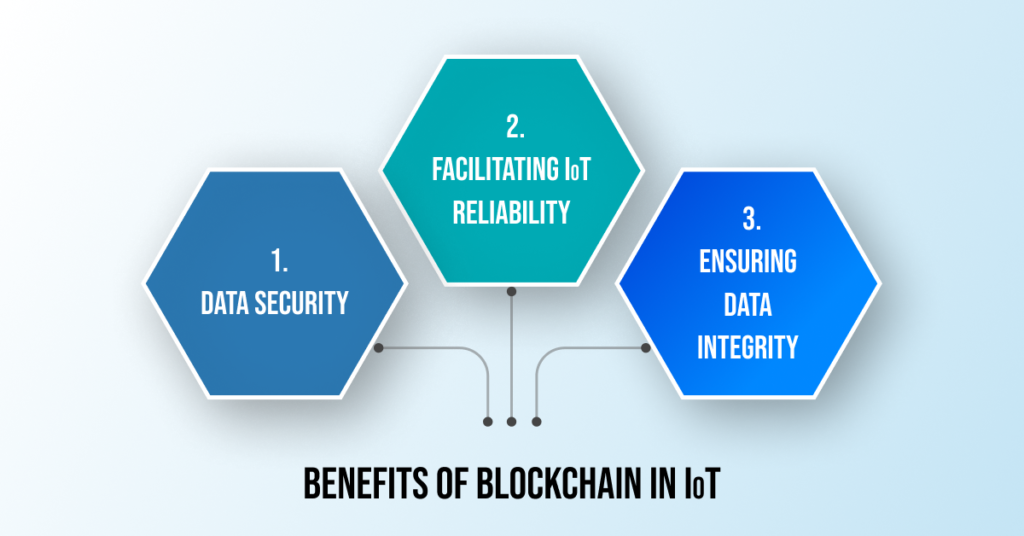
Now that you’re familiar with the peculiar applications of the Internet of Things and Blockchain let’s understand the significant advantages of Blockchain in IoT. The benefits are mentioned as follows:
- Data Security
Due to the sensitive nature of the data, security, and integrity are the foundational needs of IoT networks. Blockchain addresses this problem through its cryptographic algorithms to ensure temper-free data sharing, transfer, and storage. Only authorized devices can access the data, as the Blockchain adds an extra layer of security that is missing in conventional IoT systems.
- Facilitating IoT Reliability
A single point of failure can cause the whole IoT network to crash down. This means that typical IoT networks are prone to power outages and failure. Blockchain’s decentralized nature removes this risk and ensures the overall reliability of the IoT systems.
- Ensuring Data Integrity
The immutability of the Blockchain ensures the data integrity of the IoT devices and networks. Every entry on the Blockchain is time-stamped and linked to the previous entry, making it a series of blocks that cannot be altered or deleted. No one can modify the data once stored in the network.
Bottom Line
The collaboration of Blockchain and the Internet of Things (IoT) is a revolutionary asset to the dynamic world that prioritizes security, confidentiality, and integrity. Blockchain now plays an indispensable role in fixing the drawbacks in IoT devices, networks, and systems.
The world is about to witness more refined versions of the integration of IoT Blockchain. From smart cities to supply chain management, the two technologies are multifaceted in transforming the way how the world works.
If you’re new to Blockchain and wish to build an immersive Blockchain application of your own, Deftsoft’s refined Blockchain Developers and Engineers can help you bring your vision to life. Reach out to get started!
FAQs:
What is blockchain in IoT?
Blockchain is a distributed ledger technology popular for its decentralized and autonomous nature. The technology’s integration with IoT helps in building secure IoT networks for data collection and sharing. It allows the building of an immutable record of transactions in the IoT networks.
What are the benefits of integrating blockchain and IoT?
One major benefit of integrating blockchain with IoT is enhanced security and data integrity in IoT networks. Other benefits include increasing the reliability of IoT systems, as the blockchain’s decentralization properties remove the risk of them crashing down.
What are the challenges of blockchain in IoT?
IoT devices can range from high to low-power devices. Since blockchain requires large energy resources to function, low-power devices may struggle to integrate blockchain into them. Another significant issue is related to the non-regulation of the blockchain technology.
How are IoT and blockchain used in Fintech?
Blockchain and IoT can be used in financial systems to secure transactional records. The technologies can also facilitate novel and innovative financial services, such as secure online payments with immutable records. It can also make the fintech services efficient, fast, reliable, and cost-effective.
What is the future of IoT and blockchain?
The two technologies can integrate well to build smart cities, revolutionize healthcare systems for better patient diagnosis, and be used in edge computing and upcoming connectivity systems, such as 5G and 6G.
Recent Articles
-
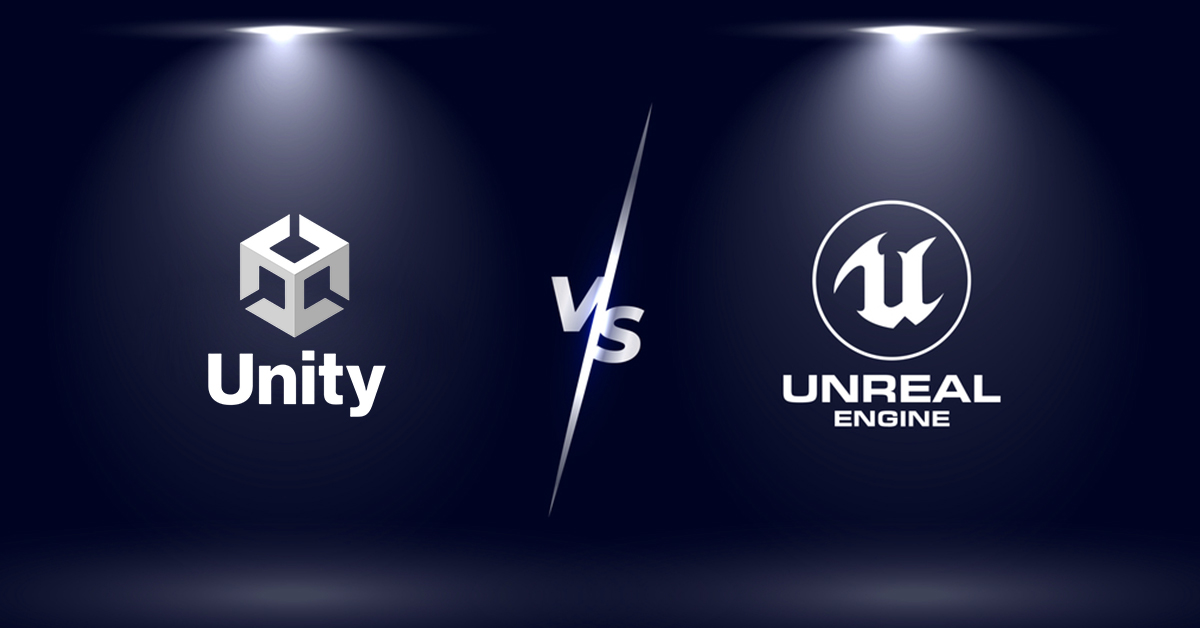
Unity vs Unreal Engine 5: Which is Better?
-

Non-Negotiable Tips for Developing a P2P Lending Platform
-

The 8 Leading Cross-Platform App Development Frameworks You Should Know
-

Step-by-Step Guide: How to Build a dApp on Ethereum with Ease
-
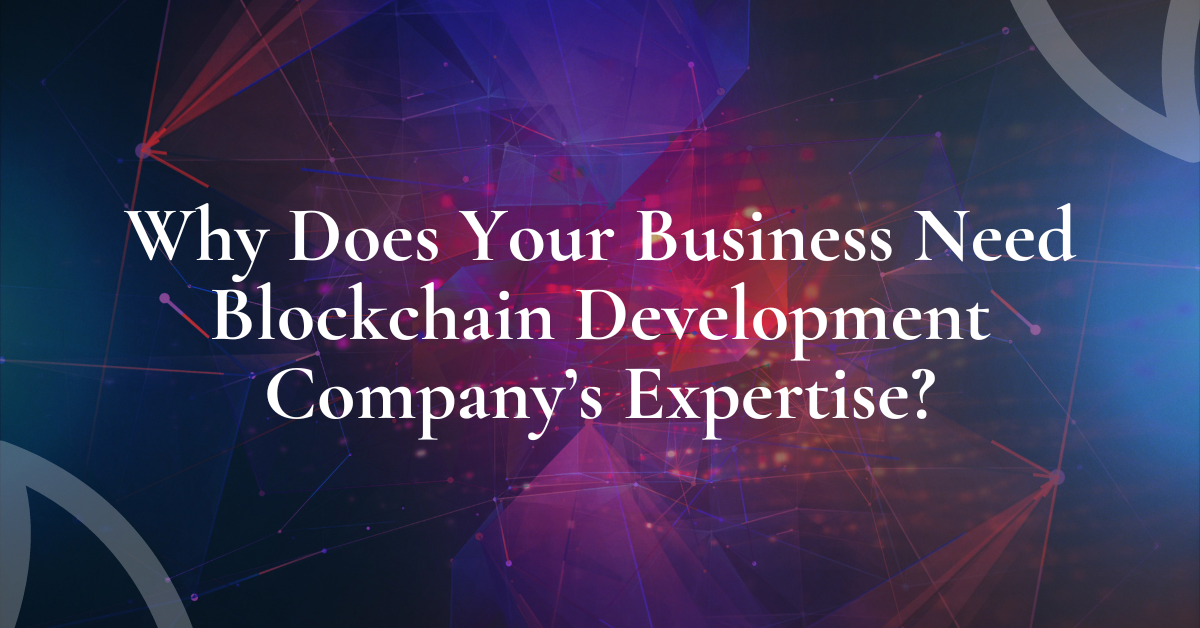
Why Does Your Business Need Blockchain Development Company’s Expertise?
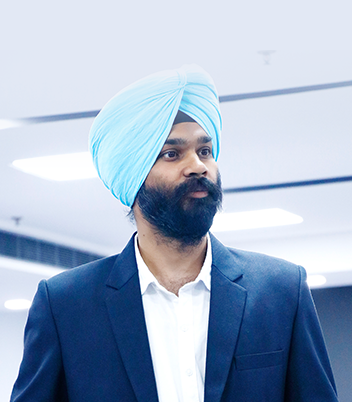
Paramjit Singh
 27th March 2024
27th March 2024